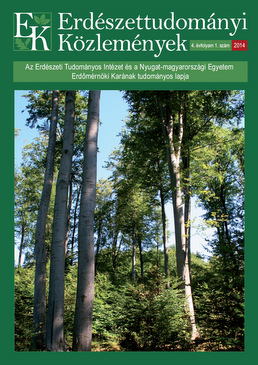Determining forest road traffic by camera surveillance
Balázs Kisfaludi
Correspondence
Correspondence: Kisfaludi Balázs
Postal address: H-9400 Sopron, Bajcsy-Zsilinszky u. 4.
e-mail: kisfaludi[at]gmail.com
Abstract
Most of the forest roads are used not only by forestry vehicles and staff, but by local inhabitants, tourists and others. Although heavy traffic is generated mostly by the vehicles connected to forestry operations. Different user groups have different needs against the geometry, the pavement type and the pavement condition of forest roads. To determine these needs, the traffic on the segments of a forest road network must be analysed. In this work, a traffic counting system and the obtained data are presented. The system consists of two retro-reflective photoelectric sensors, a safety camera and a control unit. A photo is taken whenever the light beam is interrupted. Combining the images with the data log of the sensors, the direction, the speed and the temporal distribution of the users of a particular forest road could be deduced. Based on this data, a proposal is made for the method of traffic analysis on whole road networks. As a result of this analysis the preferences of the forest road user groups could be determined. This information could be taken into account in the planning process of new forest road networks or the development of existing ones.
Keywords: traffic analysis, forest road network, public use, video surveillance
| 1. | Arnberger, A. 2006: Recreation use of urban forests: An inter-area comparison. Urban Forestry & Urban Greening, 4 (3-4): 135-144. DOI: 10.1016/j.ufug.2006.01.004 |
| 2. | Arnberger, A. and Brandenburg, C. 2002: Visitor structure of a heavily used conservation area: The Danube Floodplains National Park, Lower Austria. in: Proceedings: Conference on Monitoring and Management of Visitor Flows in Recreational and Protected Areas, 7-13. |
| 3. | Arnberger, A.; Haider, W. and Brandenburg, C. 2005: Evaluating Visitor-Monitoring Techniques: A Comparison of Counting and Video Observation Data. Environmental management, 36 (2): 317-327. DOI: 10.1007/s00267-004-8201-6 |
| 4. | Benkhard, B. and Szabó, B. 2012: Do we need mapping of tourist flows? Lessons from Börzsöny Mountain. 374-375. In: Proceedings: The 6th Conference on Monitoring and Management of Visitors in Recreational and Protected Areas. |
| 5. | Campbell, M. J. 2006: Monitoring Trail Use with Digital Still Cameras: Strengths, Limitations and Proposed Resolutions. 317-321. In: Proceedings: The Third International Conference on Monitoring and Management of Visitor Flows in Recreational and Protected Areas. |
| 6. | Cessford, G. and Muhar, A. 2003: Monitoring options for visitor numbers in national parks and natural areas. Journal for Nature Conservation, 11 (4): 240-250. DOI: 10.1078/1617-1381-00055 |
| 7. | Héjj B. 1987: Az erdei kirándulóforgalom mérése elektronika felhasználásával. Az Erdő 36 (11): 513-514. full text |
| 8. | Janowsky, D. v. and Becker, G. 2003: Characteristics and needs of different user groups in the urban forest of Stuttgart. Journal for Nature Conservation, 11 (4): 251-259. DOI: 10.1078/1617-1381-00056 |
| 9. | Kosztka M.; Markó G és Péterfalvi J. 2003: Feltáróhálózat tervezése a Börzsönyben dinamikus hálózattervezéssel. Közúti és Mélyépítési Szemle 53 (9): 22-26. |
| 10. | Li, L.; Huang W.; Gu, Y. H. and Tian, Q. 2004: Statistical modelling of complex backgrounds for foreground object detection. IEEE Transactions on Image Processing 13 (11): 1459-1472. |
| 11. | Tóth S. 1974: Erdészeti közvélemény-kutatás az erdők üdülési funkciójának vizsgálata céljából. Az Erdő 23 (9): 385-391. full text |
Arnberger, A. 2006: Recreation use of urban forests: An inter-area comparison. Urban Forestry & Urban Greening, 4 (3-4): 135-144. DOI: 10.1016/j.ufug.2006.01.004 Arnberger, A. and Brandenburg, C. 2002: Visitor structure of a heavily used conservation area: The Danube Floodplains National Park, Lower Austria. in: Proceedings: Conference on Monitoring and Management of Visitor Flows in Recreational and Protected Areas, 7-13. Arnberger, A.; Haider, W. and Brandenburg, C. 2005: Evaluating Visitor-Monitoring Techniques: A Comparison of Counting and Video Observation Data. Environmental management, 36 (2): 317-327. DOI: 10.1007/s00267-004-8201-6 Benkhard, B. and Szabó, B. 2012: Do we need mapping of tourist flows? Lessons from Börzsöny Mountain. 374-375. In: Proceedings: The 6th Conference on Monitoring and Management of Visitors in Recreational and Protected Areas. Campbell, M. J. 2006: Monitoring Trail Use with Digital Still Cameras: Strengths, Limitations and Proposed Resolutions. 317-321. In: Proceedings: The Third International Conference on Monitoring and Management of Visitor Flows in Recreational and Protected Areas. Cessford, G. and Muhar, A. 2003: Monitoring options for visitor numbers in national parks and natural areas. Journal for Nature Conservation, 11 (4): 240-250. DOI: 10.1078/1617-1381-00055 Héjj B. 1987: Az erdei kirándulóforgalom mérése elektronika felhasználásával. Az Erdő 36 (11): 513-514. full text Janowsky, D. v. and Becker, G. 2003: Characteristics and needs of different user groups in the urban forest of Stuttgart. Journal for Nature Conservation, 11 (4): 251-259. DOI: 10.1078/1617-1381-00056 Kosztka M.; Markó G és Péterfalvi J. 2003: Feltáróhálózat tervezése a Börzsönyben dinamikus hálózattervezéssel. Közúti és Mélyépítési Szemle 53 (9): 22-26. Li, L.; Huang W.; Gu, Y. H. and Tian, Q. 2004: Statistical modelling of complex backgrounds for foreground object detection. IEEE Transactions on Image Processing 13 (11): 1459-1472. Tóth S. 1974: Erdészeti közvélemény-kutatás az erdők üdülési funkciójának vizsgálata céljából. Az Erdő 23 (9): 385-391. full text
For non-commercial purposes, let others distribute and copy the article, and include in a collective work, as long as they cite the author(s) and the journal, and provided they do not alter or modify the article.
Cite this article as:
Kisfaludi, B. (2014): Determining forest road traffic by camera surveillance. Bulletin of Forestry Science, 4(1): 135-145. (in Hungarian)

Volume 4, Issue 1
Pages: 135-145
First published:
15 July 2014
More articles
by this authors
